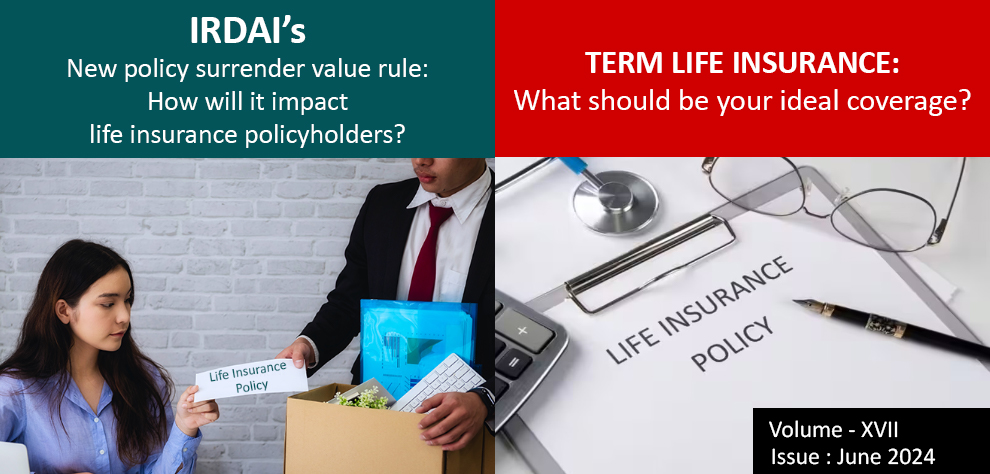TOPIC - 1
IRDAI’s New policy surrender value rule:
How will it impact life insurance policyholders?
After multiple revisions in the past, the Insurance Regulatory and Development Authority of India (IRDAI) has come out with new updates on regulations regarding the surrender value of life insurance policies.
Earlier in December last year, the draft had proposed higher surrender values for policyholders. However, the final master circular, issued now, has lower surrender value than what was proposed earlier. The value, however, is still higher than the existing rate.
The IRDAI circular has made it clear that the special surrender value rule offers policyholders the opportunity to receive a portion of their premium back even if they exit from the policies after just one year. This IRDAI move is likely to boost liquidity and flexibility for life insurance customers who may wish to switch their policies.
The special surrender value calculation, however, will be based on several other factors including the policy’s term, premium paid, and the duration for which the policy has been active. The exact formula for calculation of surrender value may vary insurer to insurer as the value is arrived at by typically considering factors such as the total premium paid, policy duration, and the surrender charges applicable.
While deciding on the surrender value, insurers shall ensure reasonableness and value for money to all types of policyholders including surrendering policyholders and continuing policyholders, the circular said.
What does the IRDAI’s proposed special surrender value mean and how is it calculated?
For those unfamiliar, surrendering a policy means you are fully withdrawing or terminating the policy before its actual term ends. The surrender value, which is paid to policyholders on surrender, is determined as the higher of the Guaranteed Surrender Value or the Special Surrender Value.
Until now, if you were surrendering your policies within two years of starting a policy, there was no provision to refund. But now if you buy a policy and pay the premium for one full year, you will be eligible for a refund of premium.
TOPIC - 2
Low premiums often mean limited coverage. It is essential to have sufficient money to cover your family’s financial needs, such as mortgage payments, children’s education and living expenses.
With term insurance, you can choose to have protection for a fixed period of time. In the event of death or total and permanent disability, the insurer pays the policyholder’s dependents. Typically, in term life insurance, no benefit is payable if the policyholder survives the insurance term.
A term life insurance is different from an endowment policy. An endowment policy is a savings-linked insurance policy with a specific maturity date. In the event of an unfortunate event such as death or disability during the period, the sum assured will be paid to your beneficiaries. Upon surviving the term, the maturity proceeds on the policy become payable.
How to choose a term life insurance?
Term life insurance is a perfect way to ensure financial security for your loved ones. However, making informed decisions while buying term insurance is very important. One should keep some important points in mind like avoiding delays, getting adequate coverage, considering the long-term costs and benefits, and keeping family informed. By being cautious and well-informed, you can choose a term insurance policy that provides your family peace of mind and financial protection.
What is an ideal term life insurance cover?
Low premiums often mean limited coverage. It is essential to have sufficient money to cover your family’s financial needs, such as mortgage payments, children’s education and living expenses.
“One’s term insurance amount should be at least 15-20 times of the annual income. For instance, if you’re earning 3 lakh per year, your coverage should be around 60 lahks,” according to Rahul Malodia, a chartered accountant and Founder & CEO, Malodia Business Coaching.
“Selecting the wrong term insurance policy can have serious consequences. Before deciding, assess your financial situation, future needs, and the policy features. Consult with a financial advisor if necessary. For instance, a young, single person might need less coverage than someone with a family and a mortgage. Make sure the policy you choose aligns with your long-term financial goals,” Malodia said.
Term insurance Vs Whole life insurance
Whole life insurance covers your entire life and includes a savings component as well. However, it is much more expensive than term insurance. Many people buy whole life insurance, thinking it’s a better investment. If your primary goal is to provide financial security for your family when you are not there, term insurance is often the more cost-effective option. Use the money saved from lower premiums to invest elsewhere.
Claim settlement ratio
The claim settlement ratio indicates the percentage of claims an insurance company has paid. A low ratio might signal potential difficulties in getting claims approved. Choose an insurer with a high claim settlement ratio to ensure your beneficiaries receive the benefits without hassle. Researching the insurer’s history and reading reviews is essential to understand their reliability.
Can you buy multiple term life insurance?
The authority has not barred life insurance companies from issuing multiple insurance policies to the same person or to a person who already holds life insurance policies from other companies. In the unfortunate event of death, beneficiaries can claim from all the life insurance policies taken by the insured. However, the insured must disclose complete details of previously purchased policies to the insurance company. Failure to do so can result in misrepresentation, which may lead to rejection of the life insurance death claim.
Additionally, attention is drawn to Section 45 of the Insurance Act, 1938, which contains provisions stating that a policy cannot be called into question on grounds of misstatement after three years.
